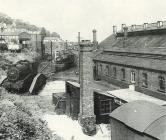Content can be downloaded for non-commercial purposes, such as for personal use or in educational resources.
For commercial purposes please contact the copyright holder directly.
Read more about the The Creative Archive Licence.
Description
Lede
How Canada, Ireland and Wales Were Connected Beneath the Sea.
Story
In our world of instant communications it’s hard to imagine that it once took ten days to send a message from North America to Europe. That was the fastest a ship could go - if the weather was favourable.
All this changed in 1858 when the first transatlantic cable was laid between Valentia Island in southern Ireland and the small settlement of Heart’s Content in Newfoundland. It was the brainwave of a wealthy American businessman, Cyrus West Field, to use recently-invented Morse code telegraphy to transmit signals across the Atlantic via a cable laid underwater. The challenge was immense but it was eventually met by two ships paying out coiled cables from each side of the Atlantic and splicing them in the middle. A congratulatory message was sent from Queen Victoria in England to the President of the United States but shortly after the cable broke. Several more attempts were made before a secure connection was achieved in 1866.
The efforts involved in manufacturing, laying and maintaining a viable cable stretching 2000 miles along the sea bed at a depth of up to 2 miles cannot be over-stated. The inner core of the cable consisted of seven strands of copper wire insulated with gutta-percha, tar, pitch, linseed oil, beeswax and more wire. The immensely heavy roll of cable had to be paid out gradually and continuously from on board a ship that was itself subject to the winds and waves of the North Atlantic. The first ships used still relied on sails as well as coal-fired steam engines, and the weight of the cable was an added risk in rough seas. Lives were lost.
The success of the 1866 cable was owed to the iron steam ship Great Eastern, designed by Isambard Kingdom Brunel, the engineering genius responsible for Britain’s first railway network. After her years as the biggest passenger liner plying between Britain and North America, the Great Eastern became a cable-laying ship, her power and stability surpassing the earlier vessels used. She was the only vessel capable of carrying the cable in its entirety and she laid it on the sea bed in just 14 days.
Once a secure telegraphic link had been established across the Atlantic to Ireland, landlines took it north from Cork to Waterford and Wexford. From there an existing cable conveyed it under the Irish Sea to Pembrokeshire – Wales and North America were connected! Onward relay to London followed.
This cable made landfall at Abermawr, a remote bay a few miles west of Fishguard. But it could have been a very different place if Isambard Kingdom Brunel (the very same!) had had his way. Years earlier in 1847, when planning the Great Western Railway route, he lit upon Abermawr as the ideal spot for the rail terminus and port he envisaged. Exploratory earth workings can still be seen behind the bay if you know where to look. As luck would have it, Brunel’s plan was stymied by the local geology; the village of Neyland further south was selected to become a transport hub instead. Abermawr, with its long shingle bank and wide wooded valley, remained the peaceful place it is today: a Site of Special Scientific Interest with prehistoric ‘drowned forest’ visible at the lowest tides.
A single reminder of the transatlantic cable connection can be seen today: above the bay the hut that served as a relay station still stands. It’s been a holiday cottage for many years but in 2016, the 150th anniversary of the laying of the telegraphic cable, a commemoration plaque was placed on the wall. It shows the Great Eastern connecting those three landfall points across a map: Fortune’s Bay, Valentia Island and Abermawr, united beneath the waves.





Do you have information to add to this item? Please leave a comment
Comments (0)
You must be logged in to leave a comment